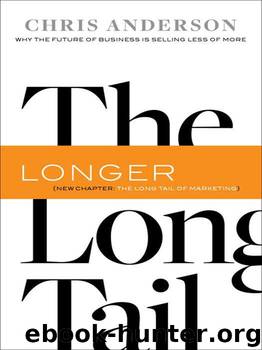The Long Tail by Chris Anderson

Author:Chris Anderson [Anderson, Chris]
Language: eng
Format: mobi, epub
Publisher: Hyperion
Published: 2006-07-11T04:00:00+00:00
SHOULD PRICES RISE OR FALL DOWN THE TAIL?
I’m often asked about the effect of the Long Tail on pricing. Should prices go down with demand as you travel down the Tail? Or should they rise, as more specific and narrowly focused goods appeal more strongly to their niche audiences?
The answer is that it depends on the product. One way to look at it is to distinguish between “want” markets and “need” markets, each of which has different implications for pricing.
Need markets are those in which customers know what they’re looking for and just can’t find it anywhere but, say, online. Take, for instance, a relatively hard-to-find nonfiction book on a topic of keen interest to you. When you find it, you’re probably going to be relatively price insensitive. You can see this effect writ large in the discounting policy at Amazon. The online bookseller discounts best-sellers by 30 to 40 percent, gradually reducing the discount until it’s around zero for the books with sales ranks in the hundred thousands.
By comparison, music and other forms of entertainment are typically “want” markets. For the right price, you can be encouraged to try something new, venturing down the Tail with diminished risk of wasting your money. Thus, many music labels have experimented with discount pricing for their older titles and more obscure new acts.
The ultimate manifestations of this would be dynamic variable pricing, where prices for music would automatically fall with popularity. That is, in fact, what Google does with its automatic auctions for keyword ads, and what eBay’s similar auctions do for everything else. The more demand there is, the higher the price goes.
A really efficient variable pricing market would presumably lead to a more gradual sales decay, and a flatter demand curve overall. But for music, at least, the adoption of such a model runs up against the advantages of single-price simplicity (as in iTunes’ fixed-price $0.99 model) and the perils of dreaded “channel conflict” with CD retailers who cannot so easily change their prices. As the music industry gets more desperate it will probably grow more bold in its search for new business models. And then we’ll have better data with which to answer this question.
Download
This site does not store any files on its server. We only index and link to content provided by other sites. Please contact the content providers to delete copyright contents if any and email us, we'll remove relevant links or contents immediately.
Influence: The Psychology of Persuasion by Robert B. Cialdini(4715)
The Miracle Morning by Hal Elrod(4636)
The Hacking of the American Mind by Robert H. Lustig(4318)
Pre-Suasion: A Revolutionary Way to Influence and Persuade by Robert Cialdini(4142)
Unlabel: Selling You Without Selling Out by Marc Ecko(3587)
Ogilvy on Advertising by David Ogilvy(3503)
Hidden Persuasion: 33 psychological influence techniques in advertising by Marc Andrews & Matthijs van Leeuwen & Rick van Baaren(3472)
Purple Cow by Seth Godin(3137)
Who Can You Trust? by Rachel Botsman(3086)
Kick Ass in College: Highest Rated "How to Study in College" Book | 77 Ninja Study Skills Tips and Career Strategies | Motivational for College Students: A Guerrilla Guide to College Success by Fox Gunnar(3070)
The Marketing Plan Handbook: Develop Big-Picture Marketing Plans for Pennies on the Dollar by Robert W. Bly(2975)
This Is Marketing by Seth Godin(2969)
I Live in the Future & Here's How It Works by Nick Bilton(2933)
The Power of Broke by Daymond John(2895)
Building a StoryBrand by Donald Miller(2838)
The Tipping Point by Malcolm Gladwell(2821)
The 46 Rules of Genius: An Innovator's Guide to Creativity (Voices That Matter) by Marty Neumeier(2796)
Draw to Win: A Crash Course on How to Lead, Sell, and Innovate With Your Visual Mind by Dan Roam(2732)
Market Wizards by Jack D. Schwager(2643)
